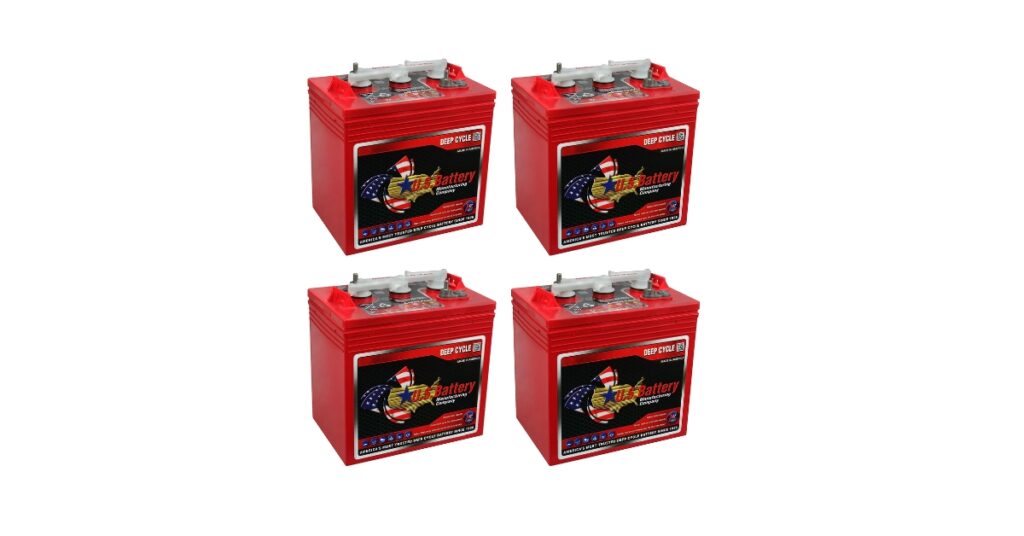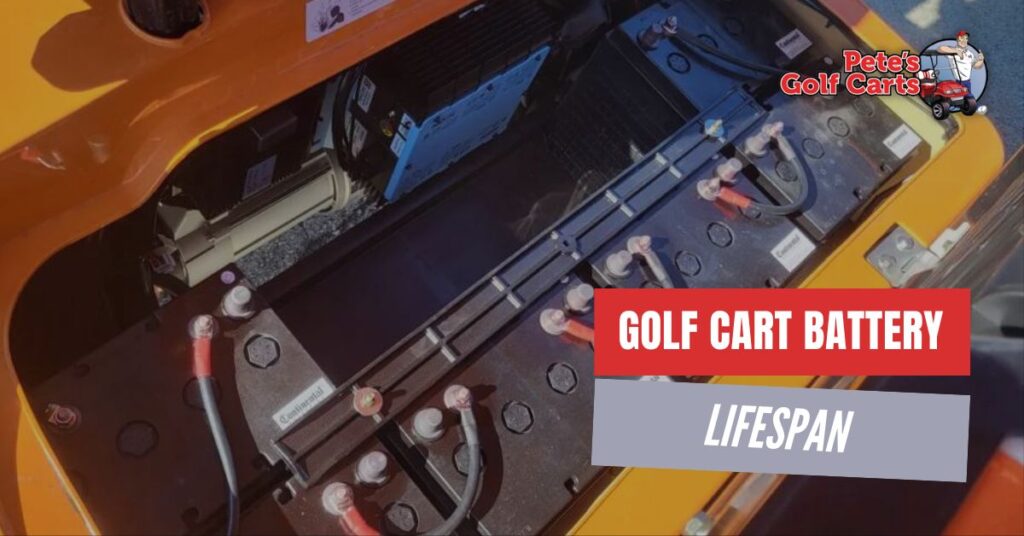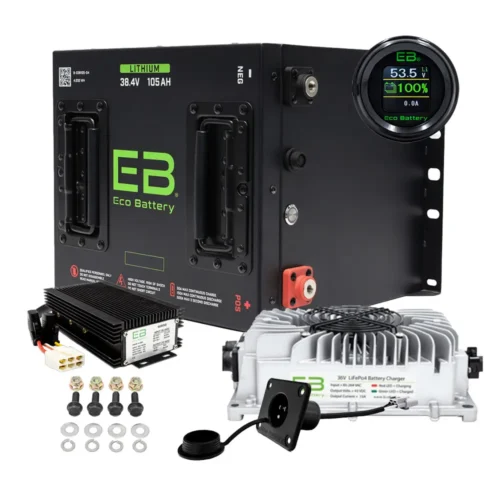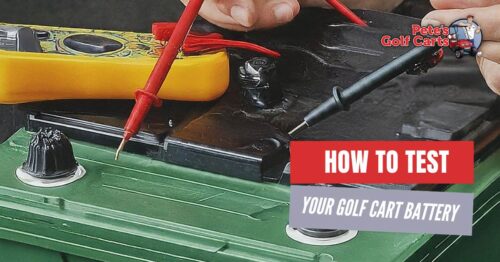Dealing with a failed golf cart battery is not only inconvenient, it’s downright frustrating. But what if you could avoid this scenario altogether? Understanding how long your golf cart batteries are supposed to last, and the factors that can shorten or extend their lifespan, is key to keeping your cart running smoothly and avoiding unexpected breakdowns.
In this comprehensive guide, we’ll delve into the world of golf cart batteries, exploring the two primary types you’ll encounter: lead-acid and lithium. We’ll uncover the secrets to maximizing their lifespan, the telltale signs of a dying battery, and how to choose the right replacement when the time comes.
How Long does it last?

You’ve probably heard different numbers thrown around when it comes to golf cart battery lifespan. Is it 4 years? 6 years? 10 years? The truth is, there’s no single answer. The lifespan of your golf cart batteries depends on a complex interplay of factors, including:
Battery Type
The type of battery technology plays a pivotal role in how long it lasts:
-
Lead-Acid Batteries: The most common type found in golf carts, lead-acid batteries typically last anywhere from 4 to 7 years. Flooded lead-acid batteries, the most basic and affordable option, generally have the shortest lifespan, while AGM and gel batteries tend to last longer due to their sealed, low-maintenance design.
-
Lithium Batteries: Lithium batteries are the new kids on the block, offering a significant lifespan advantage over their lead-acid counterparts. With proper care, lithium batteries can last 10 years or more, making them an attractive option for those seeking long-term reliability.
Other Factors at Play:
-
Usage: How often and how hard you use your golf cart significantly impacts battery life. Frequent use, driving on hilly terrain, hauling heavy loads, and aggressive driving can all accelerate battery wear.
-
Maintenance: Proper maintenance is crucial for maximizing battery lifespan. For lead-acid batteries, this involves regularly checking and topping off water levels, cleaning terminals, and performing equalization charges. While lithium batteries require minimal maintenance, ensuring proper charging and storage practices is still essential.
-
Climate: Extreme temperatures, both hot and cold, can take a toll on battery performance. High temperatures can cause the battery electrolyte to evaporate faster, while freezing temperatures can damage the internal structure of the battery.
-
Battery Age: Even with meticulous care, batteries naturally degrade over time. As they age, you may notice reduced range per charge, sluggish performance, or longer charging times.
While a general lifespan range can be provided for each battery type, it's important to remember that individual battery life is highly variable.
The Buttom Line
In-Depth Look at Lead-Acid Batteries

Lead-acid batteries have been powering golf carts for decades. While newer technologies like lithium are gaining traction, lead-acid batteries remain a popular choice due to their affordability and reliability. Let’s explore the different types, their lifespans, maintenance requirements, and common pitfalls to avoid.
- Flooded (Wet Cell):
- Pros: Most affordable option, readily available, good performance in moderate temperatures.
- Cons: Requires regular watering, prone to spills and corrosion, shorter lifespan than other lead-acid types.
- Lifespan: 4-6 years with proper maintenance.
- AGM (Absorbent Glass Mat):
- Pros: Maintenance-free (no watering needed), spill-proof, vibration resistant, better performance in extreme temperatures.
- Cons: More expensive than flooded batteries.
- Lifespan: 5-7 years, with some high-quality models lasting up to 10 years.
- Gel:
- Pros: Similar to AGM in terms of maintenance and spill-proof design, good for deep-cycle applications.
- Cons: Most expensive lead-acid option, sensitive to overcharging.
- Lifespan: 5-7 years.
Realistic Lifespan Expectations:
The lifespan of lead-acid batteries varies depending on usage and maintenance. Here’s a general guideline:
- Flooded: Expect 2-3 years with minimal maintenance or 4-6 years with diligent care.
- AGM & Gel: 5-7 years is typical, but with optimal care, they can last up to 10 years.
Signs Your Lead-Acid Battery is Dying:
- Reduced Range: Noticeably shorter distances per charge.
- Sluggish Performance: Difficulty climbing hills or accelerating.
- Slow Charging: Takes longer than usual to fully charge.
- Frequent Watering: Needing to add water more often than recommended.
- Sulfation: White, powdery buildup on battery terminals.
Maintenance Tips to Maximize Lifespan:
- Watering (Flooded Batteries Only):
- Check water levels monthly and top off with distilled water as needed.
- Never overfill, as this can lead to acid spills.
- Cleaning:
- Keep terminals clean and free of corrosion using a baking soda and water mixture.
- Apply a thin layer of petroleum jelly to prevent future corrosion.
- Charging:
- Charge fully after each use.
- Avoid overcharging, which can damage the battery.
- Equalize flooded batteries every 3-6 months to prevent cell imbalance.
- Storage:
- Fully charge before storing for extended periods.
- Store in a cool, dry place.
Common Mistakes to Avoid:
- Overcharging: Can cause water loss and damage internal components.
- Undercharging: Leads to sulfation, which reduces battery capacity.
- Neglecting Watering (Flooded Batteries): Leads to plate damage and shortened lifespan.
- Storing in Extreme Temperatures: High heat accelerates degradation, while freezing temperatures can damage the battery.
In-Depth Look at Lithium Batteries
Lithium batteries are rapidly transforming the golf cart industry, offering a host of advantages that address many of the shortcomings of traditional lead-acid batteries.
Advantages of Lithium Batteries Over Lead-Acid:
-
Extended Lifespan: Lithium batteries can last 2-3 times longer than lead-acid batteries, often exceeding 10 years of reliable service. This means fewer replacements and less hassle over the lifetime of your golf cart.
-
Faster Charging: Lithium batteries charge significantly faster than lead-acid, typically reaching full capacity in just a few hours. This means more time on the course and less time tethered to the charger.
-
Lighter Weight: Lithium batteries are considerably lighter than lead-acid, which can improve your cart’s acceleration, handling, and overall energy efficiency.
-
Maintenance-Free: Unlike lead-acid batteries, which require regular watering and cleaning, lithium batteries are virtually maintenance-free. This saves you time and effort, allowing you to focus on enjoying your golf cart.
-
Greater Efficiency: Lithium batteries deliver a more consistent power output throughout their discharge cycle, unlike lead-acid batteries, which experience voltage sag as they drain. This translates to a more reliable and enjoyable driving experience.
Types of Lithium Batteries:
-
LiFePO4 (Lithium Iron Phosphate): This is the most common type of lithium battery used in golf carts due to its exceptional safety, stability, and long cycle life. LiFePO4 batteries are known for their resistance to thermal runaway, making them a safer choice than other lithium chemistries.
-
Other Chemistries: While LiFePO4 is the dominant player, other lithium chemistries like Lithium Nickel Manganese Cobalt Oxide (NMC) and Lithium Manganese Oxide (LMO) are also used in some applications. However, LiFePO4 remains the preferred choice for golf carts due to its safety and longevity advantages.
Realistic Lifespan Expectations:
Lithium battery manufacturers often advertise lifespans of 10 years or more, and many even offer warranties to back up their claims. However, it’s important to remember that actual lifespan can vary depending on several factors:
- Battery Quality: Not all lithium batteries are created equal. High-quality batteries with reputable brand names and robust construction tend to last longer.
- Usage: Frequent deep discharges, heavy loads, and extreme temperatures can accelerate battery degradation.
- Charging Habits: Proper charging practices, such as avoiding overcharging and using a compatible charger, can significantly impact battery lifespan.
Cost vs. Benefit Analysis:
While lithium batteries have a higher upfront cost than lead-acid batteries, they can actually save you money in the long run due to their extended lifespan and minimal maintenance requirements. Here’s a quick breakdown:
- Upfront Cost: Lithium batteries can be 2-3 times more expensive than lead-acid batteries.
- Long-Term Savings: Lithium batteries typically last twice as long or more than lead-acid, meaning you won’t need to replace them as often. They also eliminate the need for regular maintenance and the associated costs.
- Performance Gains: The improved efficiency, consistent power output, and lighter weight of lithium batteries can enhance your golf cart’s performance and potentially even improve its resale value.
Ultimately, the decision to invest in lithium batteries comes down to your individual needs and budget.
When to Replace Your Golf Cart Batteries?

Beyond Lifespan: Signs of Declining Performance
Even before they completely fail, batteries gradually lose their capacity and efficiency over time. Here are some telltale signs that your golf cart batteries might be nearing the end of their lifespan:
- Reduced Range: If you notice your cart isn’t traveling as far on a single charge as it used to, this could indicate a loss of battery capacity.
- Sluggish Performance: Does your cart struggle to climb hills or accelerate as quickly as it once did? This can be a sign of aging batteries.
- Longer Charging Times: If your batteries seem to take longer and longer to charge fully, it may be due to decreased capacity.
- Frequent Need for Water (Lead-Acid Batteries): If you find yourself topping off the water levels in your flooded lead-acid batteries more often than usual, it could be a sign that they’re nearing the end of their lifespan.
Cost of Replacement vs. Cost of Repairs:
As your batteries age, you may encounter issues that could potentially be repaired. However, it’s important to weigh the cost of repairs against the cost of a full battery replacement. Factors to consider include:
- Battery Age: If your batteries are approaching or exceeding their expected lifespan, repairs may only provide a temporary fix.
- Extent of Damage: Minor issues like corroded terminals might be easily repaired, while more significant problems like damaged cells may warrant a replacement.
- Overall Battery Health: If your batteries are showing multiple signs of decline, a complete replacement might be the most cost-effective solution in the long run.
Choosing the Right Replacement:
When it’s time for new batteries, choosing the right type is crucial. Consider your budget, usage patterns, and desired features:
- Lead-Acid: If budget is your primary concern, lead-acid batteries are the most affordable option. However, they require regular maintenance and have a shorter lifespan than lithium batteries.
- Lithium: While more expensive upfront, lithium batteries offer numerous advantages, including longer lifespan, faster charging, lighter weight, and maintenance-free operation. They can be a worthwhile investment if you prioritize performance, convenience, and long-term value.
Additional Considerations:
- Warranty: Look for batteries with a solid warranty, especially for lithium options.
- Brand Reputation: Choose reputable brands known for quality and reliability.
- Battery Capacity: Make sure the new batteries have sufficient capacity to meet your needs in terms of range and power.
Wrapping Up
With this knowledge, you’re now equipped to make an informed decision about which battery type best suits your needs and budget. Consider your typical usage patterns, how much maintenance you’re willing to perform, and how long you want your batteries to last.In case you’re wondering how to replace them , read further on how to do so in this Article.









